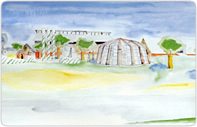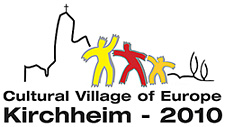Year 1996
In 1996 it all began simultaneously with the proclamation of Tommerup as Cultural Village of Europe and with the publication of "About villages" in Wijk aan Zee.
![]()
 Tommerup Cultural VIllage in 1996
Tommerup Cultural VIllage in 1996
In 1996, when Copenhagen was appointed as Cultural Capital of Europe, the Danish village Tommerup proclaimed itself to be Cultural Village of Europe and invited people from all over the world to come over to Tommerup.
About villages
In the twentieth century cities were more attractive.
First in Europe and America, later in the third world,
that was where the jobs were,
that was where the future laid ahead.
Who wanted to achieve something, moved to the city.
In the eyes of public opinion, villages were breeding nests for social control and gossip, conservative and backward.
The village as a place where creative people could not develop, where the iron rules of tradition counted and innovation was being accepted as a fate that comes over you.
Famous Dutch writers wrote about the outcasts, victems of gossip.
They wrote about family feuds, about families who were not able to deal with each other.
They described the authorative father who imposed his will and religion onto the family,
When at the same time quite other things were happening in the big world.
With the urbanization a lot of things changed.
Instead of the mutual support social laws appeared.
Instead of rest, quietness and silence verbosity and racket came up.
Instead of the dependence on familymembers or on the neighbourhood dependence of the state was introduced.
Instead of the promise or the given word the signed contract was necessary.
Slow by slow however, the glamour of the cities is faltering.
The big cities turned out to be only possible thanks to a precise organisation and regulation.
That demanded a huge number of rules and laws.
To active people these regulations became suffocating.
Even poverty has become visible again.
Regulation could not prevent that.
Cities became obstructed.
The ‘backward’ villages reappeared again.
First like an idyllic village, laying next to a creek or a windy road.
Citizens escaped to the country looking for the idylle of the beautiful nature, the Alpgreens, the moors, the otter and the black stsork, the domain of birds and butterflies.
Some bought a second home there, others moved there permanently.
It was 'green' there, time was ruled by a more relaxed speed and there was not as much noise as in the city.
But the idyllic village did not seem to exist.
In the villages frictions developed between newcomers and the families that had lived there for ages.
The newcomers wanted to import new things the original inhabitants could not see the use of.
Common democratic rights stirred up matters that the original people rather ignored and the newcomers didn’t know how to handle the special unwritten rules of the small community.
The new villagers were called 'import', the old villagers were the 'real' ones.
From above now come new demands for the country.
They want to rearrange it to make it suitable for more recreation.
Automobileorganizations and the World Naturefund have clear ideas how nature and the villages should look.
Renewal of the countryside is on the political agenda.
Bert Kisjes



















